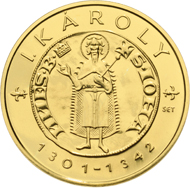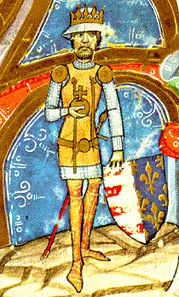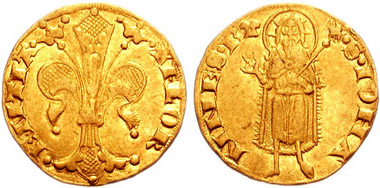June 21, 2012 – Issued by the Hungarian Mint on June 15, 2012, the Gold Florin of Charles I, the first gold florin in Hungary, is the first in a series of collector coins entitled “Gold Florins of Medieval Hungary”. The front and back of the coin in uncirculated quality are based on the gold florin of Charles I, as designed by E. Tamás Soltra, supplemented with the name of the issuing king and the dates of his reign.
The quadruple-weight piedfort version bears the edge lettering “KAROLUS REX FLORENUS 1325” and the fleur de lis motif of the Anjou House. It is limited to 1,500 pieces.
Hungary / 10,000 HUF / .986 gold / 3.491 g / 20 mm / Design: E. Tamás Solra / Mintage: 5,000.
Born of the House of Anjou in Naples, “Caroberto” or Charles Robert was the grandson of King Stephen V of Hungary through the maternal line. With termination of the House of Árpád, he was crowned King Charles I of Hungary in 1301. Despite the fact that the majority of his contemporaries did not view his first coronation or his second coronation in 1309 as being valid and that it was only his third and final coronation with the Holy Crown of Hungary at Székesfehérvár on 27 August 1310 which met all the formal requirements and was accepted as valid by all, Charles himself was of the opinion that his reign began in 1301.
Charles I of Hungary from Chronicon pictum, Marci de Kalt, Chronica de gestis Hungarorum (Képes Krónika), Széchényi Nationalbibliothek, Budapest. Source: Wikipedia.
The name of the founder of the Hungarian House of Anjou is associated with numerous monetary reforms, of which perhaps the most important was the introduction of gold coinage which was backed by the upswing in Hungarian gold mining that occurred at that time. According to estimates, in the late Middle Ages, Hungary’s gold production accounted for more than three-quarters of Europe’s total annual production.
The first mention of the Hungarian gold florin is found in the will of the bishop of Olomouc, and on this basis the start of minting Hungarian gold coins is traditionally dated to 1325. According to medieval documents, the gold florin was minted at three locations: Buda, Körmöcbánya and the mint in Transylvania.
Florentine gold florin. 1252-1422. 20mm. 3.49 g. Nerio Lippo, mintmaster. Struck second Semester 1347. Source: (C) Classical Numismatic Group, Inc. http://www.cngcoins.com license: http://creativecommons.org/licenses/by-sa/3.0/deed.en
As customary for all major mints in Europe of that age, the Hungarian gold florin was patterned after the gold coins of Florence minted from 1252 on with the fleur de lis motif, which were also known as “gold lilies” (fiorino d’oro, also the source of the Hungarian word “forint”). The gold florins of King Charles were based on this, with the inscription KAROLV.REX (King Charles) around the Florentine fleur de lis on the front and an image of Saint John the Baptist, the patron saint of the city, encircled with the legend S IOHANNES B on the back. At the end of the legend on the back, there was a small crown, which is thought to represent the mint in Buda. As this mark is found on all the known specimens, however, it is more likely that this refers to the Kingdom of Hungary as the issuer, thus clearly distinguishing this coin from the florins of Florence.
The Florentine coins were not only the pattern, they also provided the physical dimensions. According to documents from 1335-1336, the gold florins of Hungary were minted on the pattern of the Florentine florin, but were slightly heavier. As a result of these strict rules, the gold florin was minted with a weight of 3.5 grams of 23 3/4 carat “fine” gold. According to sources from the period, the gold florin of Charles I was one of the most valuable gold coins of the Middle Ages, treated as an equal to the florin of Florence and the ducat of Venice.
If you wish to get more information, please refer to the website of the Hungarian Mint.








